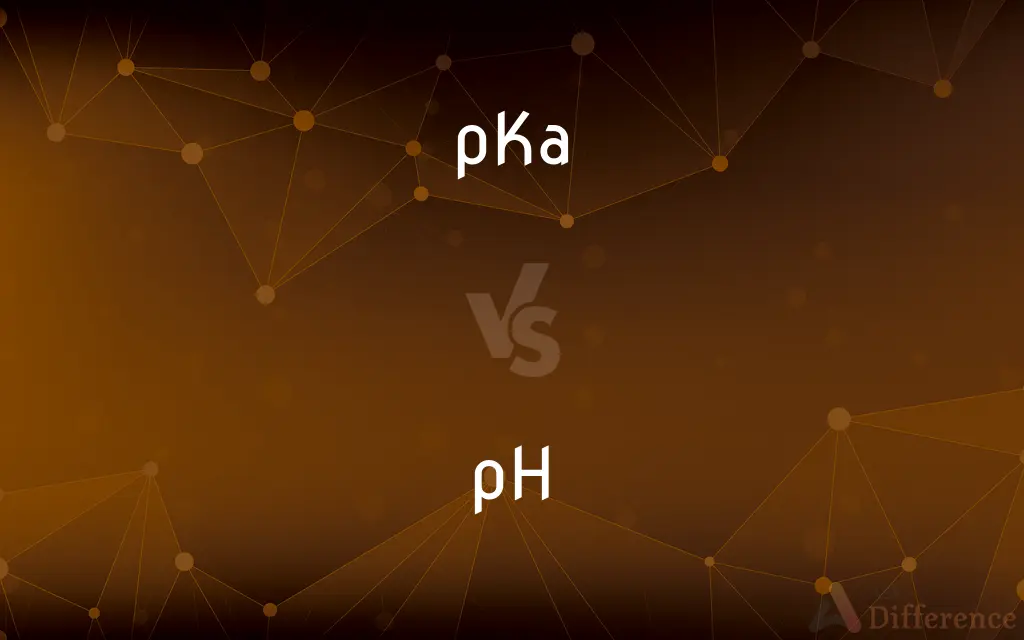pKa vs. pH — What's the Difference?
By Tayyaba Rehman — Published on December 16, 2023
pKa measures acid strength; lower values mean stronger acid. pH indicates solution's acidity or alkalinity; pH 7 is neutral, below is acidic, above is alkaline.

Difference Between pKa and pH
Table of Contents
ADVERTISEMENT
Key Differences
pKa is a constant characteristic of a specific acid, indicating the strength of that acid. It is the pH at which half of the acid has been deprotonated (given up a hydrogen ion). pH, on the other hand, is a measure of the hydrogen ion concentration in a solution, indicating the solution's acidity or basicity.
The concept of pKa originates from the acid dissociation constant (Ka). The pKa is the negative logarithm (base 10) of Ka. In contrast, pH is the negative logarithm of the hydrogen ion concentration in a solution. It determines how acidic or basic that particular solution is.
As the pKa value decreases, the acid strength increases. This means acids with low pKa values are strong acids. In the context of pH, a low pH value (below 7) indicates an acidic solution, while a high pH value (above 7) indicates a basic or alkaline solution.
Understanding the relationship between pKa and pH is essential in various fields, especially in biochemistry. The pH of a solution can influence the form (protonated or deprotonated) a molecule takes. The pKa of a molecule indicates the pH at which the molecule exists equally in both forms.
While pKa is intrinsic to a particular acid and does not change based on the environment, pH can change based on the environment and substances present in the solution. For example, adding a strong acid to water will lower its pH.
ADVERTISEMENT
Comparison Chart
Definition
Measure of acid strength.
Measure of acidity/alkalinity of a solution.
Scale Range
No specific range.
Ranges from 0 (acidic) to 14 (alkaline).
Dependency
Intrinsic to a specific acid.
Depends on the environment and substances.
Units
Dimensionless (negative logarithm of Ka).
Dimensionless (negative logarithm of H+ concentration).
Relevance
Important for predicting molecule behavior.
Useful in understanding solution properties.
Compare with Definitions
pKa
PKa helps in determining the buffering regions of weak acids and bases.
In biochemistry, knowing the pKa of an amino acid side chain is vital.
pH
PH is the negative logarithm of the hydrogen ion concentration.
Pure water at 25°C has a pH of 7, making it neutral.
pKa
PKa is the logarithmic measure of acid dissociation constant.
A lower pKa value indicates a stronger acid.
pH
PH can influence the form of molecules in a solution.
At a specific pH, molecules might exist predominantly in their protonated or deprotonated forms.
pKa
PKa is the pH at which half the molecules of an acid are deprotonated.
The pKa of acetic acid helps determine its behavior in various pH environments.
pH
PH values below 7 indicate acidity, and above 7 indicate alkalinity.
A solution with a pH of 9 is basic.
pKa
PKa values provide insight into molecule protonation states.
Based on the pKa, we can predict if a molecule will be protonated at a given pH.
pH
PH is a crucial factor in many chemical and biological processes.
Enzymes in the human body function optimally at specific pH levels.
pKa
PKa represents the resistance of an acid to changing its pH.
A strong acid will have a lower pKa, making it less resistant to pH changes.
pH
PH measures the acidity or alkalinity of a solution.
Lemon juice has a low pH, indicating its acidic nature.
pH
A measure of the acidity or alkalinity of a solution, numerically equal to 7 for neutral solutions, increasing with increasing alkalinity and decreasing with increasing acidity. The pH scale commonly in use ranges from 0 to 14.
pH
Abbr of phot
pH
Misspelling of pH
pH
Initialism of physical health
pH
A notation used in transcripts to indicate that the transcriber does not know the spelling, usually of a name, and has spelled it as it was pronounced (phonetically)
pH
(chemistry) p(otential of) H(ydrogen); the logarithm of the reciprocal of hydrogen-ion concentration in gram atoms per liter; provides a measure on a scale from 0 to 14 of the acidity or alkalinity of a solution (where 7 is neutral and greater than 7 is acidic and less than 7 is basic)
Common Curiosities
Why is pKa important in biochemistry?
pKa helps predict the protonation state of molecules at different pH levels.
What does pKa stand for?
pKa represents the negative logarithm of the acid dissociation constant (Ka).
Can pKa values change for a specific acid?
No, pKa is a constant characteristic for a specific acid.
Is pH 7 always neutral?
At 25°C, a pH of 7 is considered neutral. However, this can change with temperature.
What happens to the pH if we add an acid to a solution?
Adding an acid generally decreases the pH of a solution.
Is a molecule with a lower pKa value a stronger or weaker acid?
A molecule with a lower pKa value is a stronger acid.
How does pH relate to hydrogen ion concentration?
pH is the negative logarithm of the hydrogen ion concentration in a solution.
Can pKa and pH have the same numerical value in a solution?
Yes, when pKa equals pH, half of the acid is deprotonated.
How is pH measured?
pH is typically measured using a pH meter or pH indicator paper.
Can the pKa of a base be determined?
Yes, it can be related to the base's conjugate acid's pKa.
What role does pH play in everyday life?
pH affects processes like food preservation, digestion, and even cleaning products' efficiency.
Why is pH important for pool maintenance?
The right pH ensures effective disinfection and prevents harm to pool equipment.
Which is more specific, pKa or pH?
pKa is specific to a particular acid, while pH describes a solution's overall acidity or basicity.
Do basic solutions have low or high pH?
Basic solutions have a high pH, typically above 7.
How are pKa values determined?
pKa values can be determined experimentally using potentiometric titrations.
Share Your Discovery

Previous Comparison
Argumentative Essay vs. Persuasive Essay
Next Comparison
Amide Bond vs. Peptide BondAuthor Spotlight
Written by
Tayyaba RehmanTayyaba Rehman is a distinguished writer, currently serving as a primary contributor to askdifference.com. As a researcher in semantics and etymology, Tayyaba's passion for the complexity of languages and their distinctions has found a perfect home on the platform. Tayyaba delves into the intricacies of language, distinguishing between commonly confused words and phrases, thereby providing clarity for readers worldwide.
















































